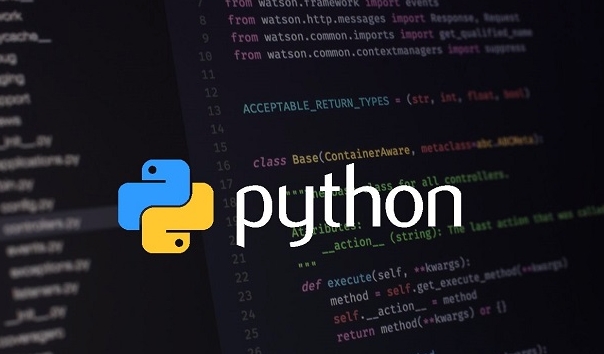There are many ways to traverse characters of strings in Python. First, use a for loop to access characters one by one, which is suitable for most scenarios; second, manually control the traversal process through indexes, which is suitable for situations where position information is needed; third, convert the string into a list or generator to process, which is suitable for data conversion or preprocessing operations; in addition, you need to pay attention to the processing of empty strings and Unicode characters.

It is actually quite straightforward to traverse characters in Python. As long as you understand the concept that strings are iterable objects, it will be very natural to operate. There are several different ways you can do it. Here are a few common and practical methods.

Use for loop to access characters one by one
This is the most commonly used and easy to understand method. Python's for loop can directly iterate over strings, and each loop variable is a character in the string.

s = "hello"
for char in s:
print(char)This method is concise and clear, suitable for most scenarios. For example, if you want to check whether each character is a vowel, or count the number of times a certain character appears, you can add a judgment or counter to this structure.
Manual control of the traversal process through index
If you need more fine-grained control, such as wanting to process the current character and the previous character at the same time, you can traverse it through the index:

s = "hello"
for i in range(len(s)):
print(s[i]) Although this method has a little more code, it allows you to access the position information of the characters. For example, if you want to determine whether two adjacent characters are the same, or iterate through the string from behind to front, you can combine range(len(s)-1, -1, -1) to achieve it.
Convert strings to lists or generators to process
Sometimes you may want to split the string into a list of characters first and then process it. This will be more convenient in some data conversion scenarios:
s = "hello"
chars = list(s)
for char in chars:
print(char)Or do some preprocessing with generator expressions, such as filtering out spaces or turning lowercase:
- Remove spaces:
char for char in s if char != ' ' - Unified conversion to lowercase:
(char.lower() for char in s)
This allows you to do some simple cleaning work while traversing.
Note: When the string is empty or contains Unicode characters
It will not report an error when traversing an empty string, but it will not enter the loop body. Pay attention to this point and avoid logical omissions.
Additionally, if a string contains Unicode characters (such as emojis or non-Latin characters), some characters may consist of multiple bytes, but they will still be treated as a single character in Python. So generally you don't need to worry about coding issues unless you are dealing with special languages ??or file input and output.
Basically these are the methods. It is not complicated but easy to ignore that the scenarios applicable to different methods are slightly different, and choosing the right tool can make the code clearer.
The above is the detailed content of How to iterate over characters in a python string?. For more information, please follow other related articles on the PHP Chinese website!

Hot AI Tools

Undress AI Tool
Undress images for free

Undresser.AI Undress
AI-powered app for creating realistic nude photos

AI Clothes Remover
Online AI tool for removing clothes from photos.

Clothoff.io
AI clothes remover

Video Face Swap
Swap faces in any video effortlessly with our completely free AI face swap tool!

Hot Article

Hot Tools

Notepad++7.3.1
Easy-to-use and free code editor

SublimeText3 Chinese version
Chinese version, very easy to use

Zend Studio 13.0.1
Powerful PHP integrated development environment

Dreamweaver CS6
Visual web development tools

SublimeText3 Mac version
God-level code editing software (SublimeText3)
 How to handle API authentication in Python
Jul 13, 2025 am 02:22 AM
How to handle API authentication in Python
Jul 13, 2025 am 02:22 AM
The key to dealing with API authentication is to understand and use the authentication method correctly. 1. APIKey is the simplest authentication method, usually placed in the request header or URL parameters; 2. BasicAuth uses username and password for Base64 encoding transmission, which is suitable for internal systems; 3. OAuth2 needs to obtain the token first through client_id and client_secret, and then bring the BearerToken in the request header; 4. In order to deal with the token expiration, the token management class can be encapsulated and automatically refreshed the token; in short, selecting the appropriate method according to the document and safely storing the key information is the key.
 Explain Python assertions.
Jul 07, 2025 am 12:14 AM
Explain Python assertions.
Jul 07, 2025 am 12:14 AM
Assert is an assertion tool used in Python for debugging, and throws an AssertionError when the condition is not met. Its syntax is assert condition plus optional error information, which is suitable for internal logic verification such as parameter checking, status confirmation, etc., but cannot be used for security or user input checking, and should be used in conjunction with clear prompt information. It is only available for auxiliary debugging in the development stage rather than substituting exception handling.
 How to iterate over two lists at once Python
Jul 09, 2025 am 01:13 AM
How to iterate over two lists at once Python
Jul 09, 2025 am 01:13 AM
A common method to traverse two lists simultaneously in Python is to use the zip() function, which will pair multiple lists in order and be the shortest; if the list length is inconsistent, you can use itertools.zip_longest() to be the longest and fill in the missing values; combined with enumerate(), you can get the index at the same time. 1.zip() is concise and practical, suitable for paired data iteration; 2.zip_longest() can fill in the default value when dealing with inconsistent lengths; 3.enumerate(zip()) can obtain indexes during traversal, meeting the needs of a variety of complex scenarios.
 What are python iterators?
Jul 08, 2025 am 02:56 AM
What are python iterators?
Jul 08, 2025 am 02:56 AM
InPython,iteratorsareobjectsthatallowloopingthroughcollectionsbyimplementing__iter__()and__next__().1)Iteratorsworkviatheiteratorprotocol,using__iter__()toreturntheiteratorand__next__()toretrievethenextitemuntilStopIterationisraised.2)Aniterable(like
 What are Python type hints?
Jul 07, 2025 am 02:55 AM
What are Python type hints?
Jul 07, 2025 am 02:55 AM
TypehintsinPythonsolvetheproblemofambiguityandpotentialbugsindynamicallytypedcodebyallowingdeveloperstospecifyexpectedtypes.Theyenhancereadability,enableearlybugdetection,andimprovetoolingsupport.Typehintsareaddedusingacolon(:)forvariablesandparamete
 Python FastAPI tutorial
Jul 12, 2025 am 02:42 AM
Python FastAPI tutorial
Jul 12, 2025 am 02:42 AM
To create modern and efficient APIs using Python, FastAPI is recommended; it is based on standard Python type prompts and can automatically generate documents, with excellent performance. After installing FastAPI and ASGI server uvicorn, you can write interface code. By defining routes, writing processing functions, and returning data, APIs can be quickly built. FastAPI supports a variety of HTTP methods and provides automatically generated SwaggerUI and ReDoc documentation systems. URL parameters can be captured through path definition, while query parameters can be implemented by setting default values ??for function parameters. The rational use of Pydantic models can help improve development efficiency and accuracy.
 How to test an API with Python
Jul 12, 2025 am 02:47 AM
How to test an API with Python
Jul 12, 2025 am 02:47 AM
To test the API, you need to use Python's Requests library. The steps are to install the library, send requests, verify responses, set timeouts and retry. First, install the library through pipinstallrequests; then use requests.get() or requests.post() and other methods to send GET or POST requests; then check response.status_code and response.json() to ensure that the return result is in compliance with expectations; finally, add timeout parameters to set the timeout time, and combine the retrying library to achieve automatic retry to enhance stability.
 Setting Up and Using Python Virtual Environments
Jul 06, 2025 am 02:56 AM
Setting Up and Using Python Virtual Environments
Jul 06, 2025 am 02:56 AM
A virtual environment can isolate the dependencies of different projects. Created using Python's own venv module, the command is python-mvenvenv; activation method: Windows uses env\Scripts\activate, macOS/Linux uses sourceenv/bin/activate; installation package uses pipinstall, use pipfreeze>requirements.txt to generate requirements files, and use pipinstall-rrequirements.txt to restore the environment; precautions include not submitting to Git, reactivate each time the new terminal is opened, and automatic identification and switching can be used by IDE.






